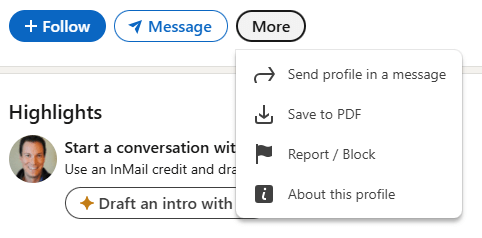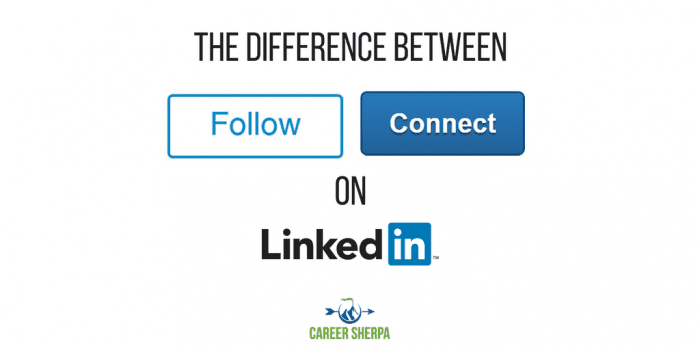Are you sending connection requests on LinkedIn and hearing crickets? Or wondering why you’re seeing updates from someone you’re not connected to? Let’s clear up the confusion between following and connecting.
Why Some People Don’t Accept Connection Requests
One of the biggest debates among LinkedIn users is who you should connect with. People have different opinions.
LinkedIn says
“We recommend only inviting people you know and trust because 1st-degree connections are given access to the primary email address on your account.”
As a result, many users will NOT accept invitations to connect unless they know you. Conversely, some people are LIONS (LinkedIn Open Networkers) and will connect with anyone who invites them.
If you really want to stay in touch with someone these are a couple of workarounds.
Two Ways to Get Updates and Stay In Touch With Someone On LinkedIn
If you want to connect with someone you don’t personally know, try either of these options.
1) Send a customized invitation to connect
In your note, explain why you are interested in connecting with the person. It isn’t a guarantee that your invitation will be accepted, but it may increase the chances.
Watch this short video by Brenda Meller as she walks you through exactly how to send a personalized note with each invitation.
2) Follow the person on LinkedIn
This is how LinkedIn describes the differences between following and connecting.
Connections are two-way relationships of trust between people who know each other. If you’re connected to someone, you’re following them and they’re following you by default.
Your followers will receive your posts, articles, and shares in their LinkedIn homepage feed. Members don’t have to be connected to you to follow you and receive these updates.
You’ll only be able to follow if the person has changed their privacy settings to enable updates to be publicly follow-able.
While following someone means you might see their posts, LinkedIn’s algorithm favors content from your 1st-degree connections.
TIP: LinkedIn now limits the number of invitations to 100 per week. If you’ve reached that limit, consider following the person until you can invite them to connect.
Follow Influencers & Media
Perhaps you want to follow some of LinkedIn’s Influencers or people who have written articles on LinkedIn, go to their LinkedIn profile, click on one of their posts, and you will see the FOLLOW button.
An easy way to follow someone’s public updates on LinkedIn is to visit their profile and click the “+Follow” button, or click the “More” button and choose “Follow”—if they’ve enabled this option.

Advice for Content Creators, Speakers, and Business Owners
If you’re growing your personal brand, consider encouraging people to follow you rather than connect—especially if you’re near your connection limit (30,000). You can also add “Follow me on LinkedIn for tips on [your niche]” to your headline or About section.
LinkedIn’s Help Center post Follow and Connect explains how:
Following someone on LinkedIn allows you to see the person’s posts and articles on your homepage without being connected to them. However, the person you’re following won’t see your posts. By default, you will follow your 1st degree connections, and you can always unfollow them.
You can reach a larger audience by encouraging others to follow your activity and read what you’re sharing on LinkedIn, without adding 1st degree connections to your network.
- Select Settings & Privacy from the dropdown.
- Click the Privacy tab at the top of the page.
- Under the Blocking and hiding section, click Change next to Followers.
- From the dropdown, select one of the following options:
- Everyone on LinkedIn – All LinkedIn members, in and outside your network, can follow your posts.
- Your connections – Only your 1st-degree connections can follow your posts.
How To Handle Requests To Connect From Strangers
In an interesting discussion thread on Facebook, people were discussing how they handle requests from strangers. Some said they send a reply to the invitation, requesting the sender to explain how they know each other or why they want to connect. The response rate to those emails was mixed. As a business owner, accepting invitations from people you don’t know may not bother you, these are leads, right? But even LinkedIn is seeing it’s share of spam accounts, so be aware.
You may choose to send a reply message in which you explain your preference that people follow you rather than connect. You might also explain your logic for not connecting with people you do not know.
The Bottom Line
Whether you’re expanding your network or growing your audience, understanding how LinkedIn’s follow and connect features work will help you make smarter networking choices. Start by adjusting your settings—and decide what kind of connections you want to build.

Hannah Morgan speaks and writes about job search and career strategies. She founded CareerSherpa.net to educate professionals on how to maneuver through today’s job search process. Hannah was nominated as a LinkedIn Top Voice in Job Search and Careers and is a regular contributor to US News & World Report. She has been quoted by media outlets, including Forbes, USA Today, Money Magazine, Huffington Post, as well as many other publications. She is also author of The Infographic Resume and co-author of Social Networking for Business Success.


